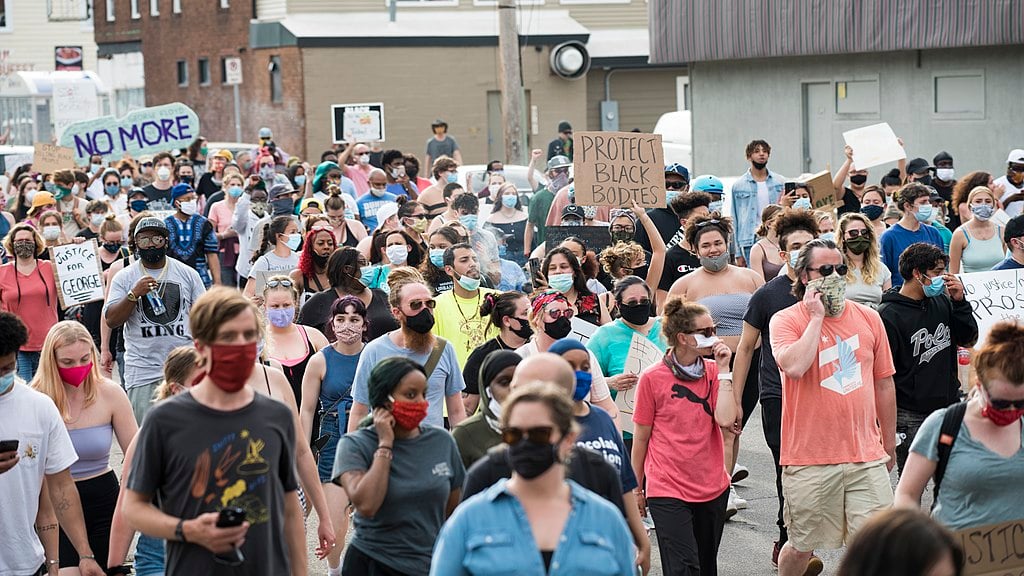U.S. Current Trend: Militarization, the Freedom of Assembly, and the George Floyd Protests
Protests have spread across major U.S. cities over police violence against people of color, sparked by the killing of George Floyd by police officers in Minneapolis, Minnesota. The police response to these protests has often been militarized and aggressive, targeting not only peaceful protesters but also members of the media with arrests and violence.
While the police have a clear duty to respond when individuals engage in violence, their militarized approach to the George Floyd protests has often escalated tensions and led to further confrontation. Any use of force by the police should be guided by the principles of proportionality and necessity, and carefully targeted at those individuals engaged in violence themselves.

Police departments across the U.S. have wide access to military gear that has been used in the policing of protests. During the recent demonstrations, the police have repeatedly used rubber bullets, tear gas, and flash grenades. These militarized responses often make the situation worse and instead police should use tactics that lead to de-escalation and work to improve community engagement.
CONCERN OVER USE OF MILITARY TO POLICE PROTESTS
Governors in at least twelve states have activated the National Guard, and the Pentagon has reportedly been preparing to send military police to areas affected by protests. President Trump, meanwhile, tweeted that if “liberal governors and mayors” did not get “tougher,” then the federal government would use the “unlimited power of our military.” In Washington DC, the Secretary of Army called up the national guard which were deployed around the White House to confront protesters.
These actions raise significant concerns about how the military is being used to police protests in the United States. The military is generally not trained to police civilian protests and their presence risks further escalating confrontations with protesters and undermining assembly rights. Under the Insurrection Act, the President has the authority to call in the US military, including federally controlled national guard troops, but only under limited circumstances, and this power has not been used without the permission of a state’s governor in modern times. If the President were to unilaterally call in the US military or federalize the national guard, it would raise serious constitutional questions and could lead to confusion about whether the state or federal government is in charge of policing. Under international law, the military should generally not police protests and, if it does, it must always be subordinate to civilian authorities.
DOMESTIC ENTITIES CANNOT BE DESIGNATED AS “TERRORIST ORGANIZATIONS”
President Trump has said that the U.S. plans to designate ANTIFA as a “terrorist organization,” blaming the group for violence surrounding the George Floyd protests. (ANTIFA is short for “anti-fascist.”) However, under US law there is no legal authority to designate domestic entities as a “terrorist organization”.
Such a label would also raise significant First Amendment concerns as it would seem to ban a group based on its ideology. Since ANTIFA does not have clear membership this would also risk criminalizing the First Amendment protected activity of those who shared similar beliefs to ANTIFA. As such, those who protested police violence in the future could face being labeled part of a terrorist organization.
DEMONSTRATIONS SHOULD NOT LEAD TO NEW ANTI-PROTEST BILLS
Protests over police violence against people of color in the US have in the past led state legislators to introduce laws that restrict the freedom of peaceful assembly, as documented in ICNL’s Protest Law Tracker. For example, in response to Black Lives Matter protests that took place in streets and on highways, bills were introduced in numerous states that would eliminate civil liability for drivers who unintentionally hit protesters with their car, or that would significantly heighten penalties for traffic interference.
It is important that legislators do not use the current protests as a pretext to undermine Americans’ First Amendment right to the freedom of assembly. Instead, legislators should use this moment to ensure that laws and police departments protect peaceful assemblies, apply the principles of necessity and proportionality when addressing violence, and–most importantly–contribute to de-escalation and addressing grievances from communities that have been subject to biased and racialized policing.
May 31, 2020